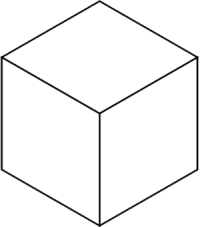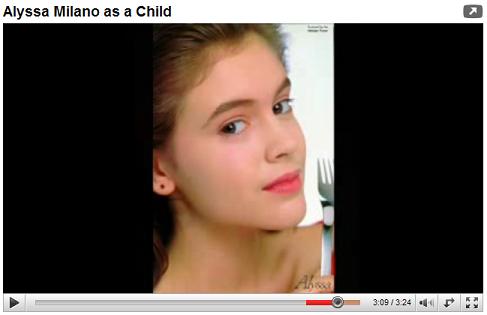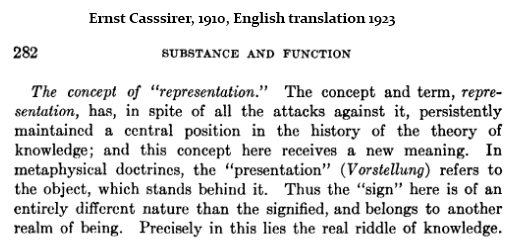Tuesday, May 21, 2019
Inside the White Cube
Saturday, May 4, 2019
Inside the White Cube
See also Espacement and The Thing and I.
Sunday, December 20, 2020
Looking Firmly
“… and the song of love’s recision is the music of the spheres.”
— E. L. Doctorow, City of God
Doctorow’s remark was quoted here earlier, on February 5, 2009 —
The central aim of Western religion–
"Each of us has something to offer the Creator... the bridging of masculine and feminine, life and death. It's redemption.... nothing else matters." -- Martha Cooley in The Archivist (1998) The central aim of Western philosophy– Dualities of Pythagoras as reconstructed by Aristotle: Limited Unlimited Odd Even Male Female Light Dark Straight Curved ... and so on .... “Of these dualities, the first is the most important; all the others may be seen as different aspects of this fundamental dichotomy. To establish a rational and consistent relationship between the limited [man, etc.] and the unlimited [the cosmos, etc.] is… the central aim of all Western philosophy.” — Jamie James in The Music of the Spheres (1993) “In the garden of Adding — The Midrash Jazz Quartet in City of God, by E. L. Doctorow (2000) A quotation today at art critic Carol Kino’s website, slightly expanded: “Art inherited from the old religion — Octavio Paz,”Seeing and Using: Art and Craftsmanship,” in Convergences: Essays on Art and Literature (New York: Harcourt Brace Jovanovich 1987), 52 From Brian O’Doherty’s 1976 Artforum essays– not on museums, but rather on gallery space: “We have now reached
“Space: what you — James Joyce, Ulysses |
Saturday, June 6, 2020
Inside Job

A film not unrelated to the screen career
of Sophia Lillis: Inside Daisy Clover.
I prefer Inside the White Cube.
Tuesday, April 4, 2017
White Cube
“We have now reached
a point where we see
not the art but the space first….
An image comes to mind
of a white, ideal space
that, more than any single picture,
may be the archetypal image
of 20th-century art.”

“Space: what you
damn well have to see.”
— James Joyce, Ulysses
Thursday, February 27, 2014
Sacred Space, continued
"An image comes to mind of a white, ideal space
that, more than any single picture, may be the
archetypal image of 20th-century art."
— Brian O'Doherty, "Inside the White Cube"
Cube spaces exist also in mathematics.
Thursday, January 24, 2013
Cube Space
For the late Cardinal Glemp of Poland,
who died yesterday, some links:

Thursday, December 27, 2012
Thursday, November 25, 2010
Art Object, continued
"An image comes to mind of a white, ideal space
that, more than any single picture, may be
the archetypal image of 20th-century art."
"May be" —

Image from this journal
at noon (EST) Tuesday
"The geometry of unit cubes is a meeting point
of several different subjects in mathematics."
— Chuanming Zong
"A meeting point" —

The above death reportedly occurred "early Wednesday in Beijing."
Another meeting point —
(Click on logo and on meeting image for more details.)
See also "no ordinary venue."
Saturday, March 6, 2010
Deconstructing Alice
Alyssa is Wonderland
Manohla Dargis in The New York Times yesterday—
“Of course the character of Carroll’s original Alice is evident in each outrageous creation she dreams up in ‘Wonderland’ and in the sequel, ‘Through the Looking-Glass,’ which means that she’s a straight man to her own imagination. (She is Wonderland.)”

From Inside the White Cube—
“The sacramental nature of the space becomes clear, and so does one of the great projective laws of modernism: as modernism gets older, context becomes content. In a peculiar reversal, the object introduced into the gallery ‘frames’ the gallery and its laws.”
From Yogi Berra–
“When you come to a fork in the road, take it.”
Related material: For Baron Samedi and…
Sunday, October 11, 2009
Sunday October 11, 2009
Today I revised the illustrations
in Finite Geometry of the
Square and Cube
for consistency in labeling
the eightfold cube.
Related material:
Thursday, April 2, 2009
Thursday, February 5, 2009
Thursday February 5, 2009
Through the
Looking Glass:
A Sort of Eternity
From the new president’s inaugural address:
“… in the words of Scripture, the time has come to set aside childish things.”
The words of Scripture:
“through a glass”—
[di’ esoptrou].
By means of
a mirror [esoptron].
Childish things:

fom the Inventing Kindergarten
exhibit at The Institute for Figuring
(co-founded by Margaret Wertheim)
Not-so-childish:
Three planes through
the center of a cube
that split it into
eight subcubes:

Through a glass, darkly:
A group of 8 transformations is
generated by affine reflections
in the above three planes.
Shown below is a pattern on
the faces of the 2x2x2 cube
that is symmetric under one of
these 8 transformations–
a 180-degree rotation:
(Click on image
for further details.)
But then face to face:
A larger group of 1344,
rather than 8, transformations
of the 2x2x2 cube
is generated by a different
sort of affine reflections– not
in the infinite Euclidean 3-space
over the field of real numbers,
but rather in the finite Galois
3-space over the 2-element field.

Galois age fifteen,
drawn by a classmate.
These transformations
in the Galois space with
finitely many points
produce a set of 168 patterns
like the one above.
For each such pattern,
at least one nontrivial
transformation in the group of 8
described above is a symmetry
in the Euclidean space with
infinitely many points.
For some generalizations,
see Galois Geometry.
Related material:
The central aim of Western religion–
"Each of us has something to offer the Creator... the bridging of masculine and feminine, life and death. It's redemption.... nothing else matters." -- Martha Cooley in The Archivist (1998) The central aim of Western philosophy– Dualities of Pythagoras as reconstructed by Aristotle: Limited Unlimited Odd Even Male Female Light Dark Straight Curved ... and so on .... “Of these dualities, the first is the most important; all the others may be seen as different aspects of this fundamental dichotomy. To establish a rational and consistent relationship between the limited [man, etc.] and the unlimited [the cosmos, etc.] is… the central aim of all Western philosophy.” — Jamie James in The Music of the Spheres (1993) “In the garden of Adding — The Midrash Jazz Quartet in City of God, by E. L. Doctorow (2000) A quotation today at art critic Carol Kino’s website, slightly expanded: “Art inherited from the old religion — Octavio Paz,”Seeing and Using: Art and Craftsmanship,” in Convergences: Essays on Art and Literature (New York: Harcourt Brace Jovanovich 1987), 52 From Brian O’Doherty’s 1976 Artforum essays– not on museums, but rather on gallery space: “We have now reached
“Space: what you — James Joyce, Ulysses |
Tuesday, January 6, 2009
Tuesday January 6, 2009
and Dyson on Jung
The current (Feb. 2009) Notices of the American Mathematical Society has a written version of Freeman Dyson's 2008 Einstein Lecture, which was to have been given in October but had to be canceled. Dyson paraphrases a mathematician on Carl Jung's theory of archetypes:
"… we do not need to accept Jung’s theory as true in order to find it illuminating."
The same is true of Jung's remarks on synchronicity.
For example —
Yesterday's entry, "A Wealth of Algebraic Structure," lists two articles– each, as it happens, related to Jung's four-diamond figure from Aion as well as to my own Notes on Finite Geometry. The articles were placed online recently by Cambridge University Press on the following dates:
R. T. Curtis's 1974 article defining his Miracle Octad Generator (MOG) was published online on Oct. 24, 2008.
Curtis's 1987 article on geometry and algebraic structure in the MOG was published online on Dec. 19, 2008.
On these dates, the entries in this journal discussed…
Oct. 24:
Cube Space, 1984-2003
Material related to that entry:
Dec. 19:
Art and Religion: Inside the White Cube
That entry discusses a book by Mark C. Taylor:
The Picture in Question: Mark Tansey and the Ends of Representation (U. of Chicago Press, 1999).
"What, then, is a frame, and what is frame work?"
One possible answer —
Hermann Weyl on the relativity problem in the context of the 4×4 "frame of reference" found in the above Cambridge University Press articles.
windows of knowledge."
— Vladimir Nabokov
Thursday, May 22, 2008
Thursday May 22, 2008
An Exercise in
Conceptual Art
THE JUDGMENT
Undertakings bring misfortune.
Nothing that would further.

“Brian O’Doherty, an Irish-born artist,
before the [Tuesday, May 20] wake
of his alter ego* ‘Patrick Ireland’
on the grounds of the
Irish Museum of Modern Art.”
— New York Times, May 22, 2008
THE IMAGE
Thus the superior man
understands the transitory
in the light of
the eternity of the end.
Another version of
the image:
See 2/22/08
and 4/19/08.
Michael Kimmelman in today’s New York Times—
“An essay from the ’70s by Mr. O’Doherty, ‘Inside the White Cube,’ became famous in art circles for describing how modern art interacted with the gallery spaces in which it was shown.”
Brian O’Doherty, “Inside the White Cube,” 1976 Artforum essays on the gallery space and 20th-century art:
“The history of modernism is intimately framed by that space. Or rather the history of modern art can be correlated with changes in that space and in the way we see it. We have now reached a point where we see not the art but the space first…. An image comes to mind of a white, ideal space that, more than any single picture, may be the archetypal image of 20th-century art.”

“Nothing that would further.”
— Hexagram 54
|
…. Now thou art an 0 |
“…. in the last mystery of all the single figure of what is called the World goes joyously dancing in a state beyond moon and sun, and the number of the Trumps is done. Save only for that which has no number and is called the Fool, because mankind finds it folly till it is known. It is sovereign or it is nothing, and if it is nothing then man was born dead.”
— The Greater Trumps,
by Charles Williams, Ch. 14
















